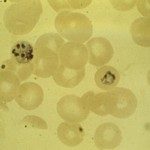Link to Pubmed [PMID] – 36847467
Link to DOI – 10.5802/crbiol.95
C R Biol 2022 Dec; 345(2): 91-133
Vivax malaria is an infectious disease caused by Plasmodium vivax, a parasitic protozoan transmitted by female Anopheline mosquitoes. Historically, vivax malaria has often been regarded as a benign self-limiting infection due to the observation of low parasitemia in Duffy-positive patients in endemic transmission areas and the virtual absence of infections in Duffy-negative individuals in Sub Saharan Africa. However, the latest estimates show that the burden of the disease is not decreasing in many countries and cases of vivax infections in Duffy-negative individuals are increasingly reported throughout Africa. This raised questions about the accuracy of diagnostics and the evolution of interactions between humans and parasites. For a long time, our knowledge on P. vivax biology has been hampered due to the limited access to biological material and the lack of robust in vitro culture methods. Consequently, little is currently known about P. vivax blood stage invasion mechanisms. The introduction of omics technologies with novel and accessible techniques such as third generation sequencing and RNA sequencing at single cell level, two-dimensional electrophoresis, liquid chromatography, and mass spectrometry, has progressively improved our understanding of P. vivax genetics, transcripts, and proteins. This review aims to provide broad insights into P. vivax invasion mechanisms generated by genomics, transcriptomics, and proteomics and to illustrate the importance of integrated multi-omics studies.Le paludisme à Plasmodium vivax est une maladie infectieuse causée par un parasite protozoaire Plasmodium vivax, transmis par les moustiques Anophèle femelles. Historiquement, le paludisme à P. vivax a souvent été considéré comme une infection bénigne en raison de l’observation d’une faible parasitémie chez les patients Duffy-positifs dans les zones d’endémie et de la quasi-absence d’infections chez les individus Duffy-négatifs vivant majoritairement en Afrique subsaharienne. Cependant, les dernières estimations montrent que le poids de la maladie ne diminue pas dans de nombreux pays et que des cas d’infections à P. vivax chez des individus Duffy-négatifs sont de plus en plus souvent observés en Afrique. Cela soulève des interrogations sur la précision des diagnostics et l’évolution des interactions hôte-parasite. Pendant longtemps, nos connaissances sur la biologie de P. vivax ont été entravées par un accès limité au matériel biologique et un manque de méthodes robustes pour la culture in vitro. Par conséquent, nous n’avons encore que peu d’informations concernant les mécanismes d’invasion des stades sanguins de P. vivax. L’introduction des technologies dites « omiques », avec le développement de techniques innovantes et abordables telles que le séquençage d’ADN de troisième génération, le séquençage ARN à l’échelle de la cellule « single-cell », l’électrophorèse bidimensionnelle, la chromatographie liquide et la spectrométrie de masse, a progressivement amélioré notre compréhension des gènes, des transcrits et des protéines de P. vivax. Cette revue a non seulement pour but de fournir un aperçu général des mécanismes d’invasion de P. vivax acquis grâce aux techniques génomiques, transcriptomiques et protéomiques mais également d’illustrer l’importance de la complémentarité de ces approches.

